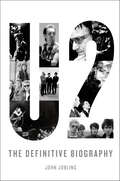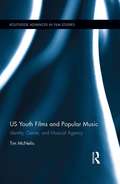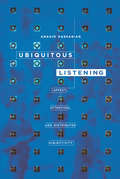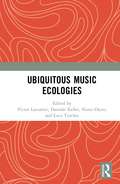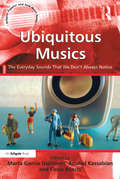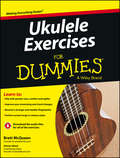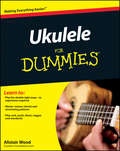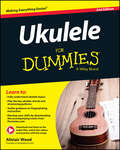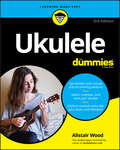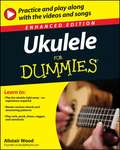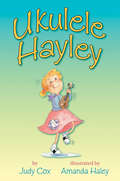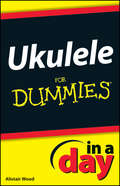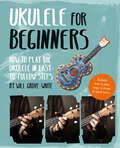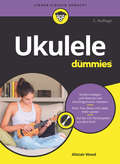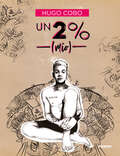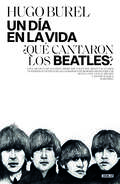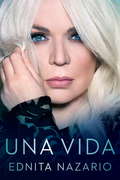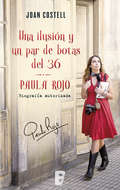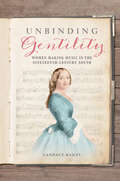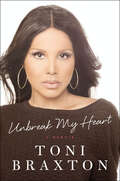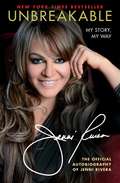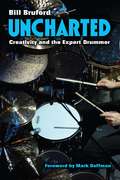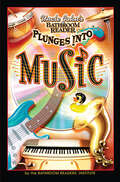- Table View
- List View
U2: The Definitive Biography
by John JoblingJohn Jobling takes readers beyond the myth in this unauthorized biography of U2 to present the first comprehensive account of the illustrious Irish rockers in 25 years. Drawing on extensive interviews with insiders including record label scouts, studio presidents, politicians, music critics, and childhood friends, Jobling investigates the U2's most personal relationships and controversial business practices, delivering a vivid portrait that traces the rock phenomenon from its conception to post-punk champions to political crusaders. Filled with captivating revelations, reader will learn:- How Bono, the Edge, and Larry Mullen, Jr. worshiped with a Charismatic Christian church that practiced speaking in tongues during the band's early days- Insider stories of the genesis and recording of classic albums such as The Joshua Tree and Achtung Baby- Creative tensions within the band and power struggles among management- How the disappointments of the Rattle and Hum film and PopMart Tour spurred the band to greater creative heights- Both the successes and controversies of Bono's wide-sweeping philanthropic and political ventures- The disconnect between the band's personal lives and public personasSure to inspire debate with every music lover, U2: The Definitive Biography humanizes the band and paints an honest picture of a band's rise to the top, plunging into the heart and underlying soul of this iconic rock and roll band.
U2: The Secret History (The\secret History Of Rock Ser.)
by Alan CrossAlan Cross is the preeminent chronicler of popular music.Here he provides a history of U2.This look at the band—"Four Hearts Beat as One"—is adapted from the audiobook of the same name.
US Youth Films and Popular Music: Identity, Genre, and Musical Agency (Routledge Advances in Film Studies)
by Tim McNelisThis book brings theory from popular music studies to an examination of identity and agency in youth films while building on, and complementing, film studies literature concerned with genre, identity, and representation. McNelis includes case studies of Hollywood and independent US youth films that have had commercial and/or critical success to illustrate how films draw on specific discourses surrounding popular music genres to convey ideas about gender, race, ethnicity, sexuality, and other aspects of identity. He develops the concept of ‘musical agency’, a term he uses to discuss the relationship between film music and character agency, also examining the music characters listen to and discuss, as well as musical performances by the characters themselves
Ubiquitous Listening: Affect, Attention, and Distributed Subjectivity
by Anahid KassabianHow does the constant presence of music in modern life--on iPods, in shops and elevators, on television--affect the way we listen? With so much of this sound, whether imposed or chosen, only partially present to us, is the act of listening degraded by such passive listening? In Ubiquitous Listening, Anahid Kassabian investigates the many sounds that surround us and argues that this ubiquity has led to different kinds of listening. Kassabian argues for a new examination of the music we do not normally hear (and by implication, that we do), one that examines the way it is used as a marketing tool and a mood modulator, and exploring the ways we engage with this music.
Ubiquitous Music Ecologies
by Damián Keller Victor Lazzarini Nuno Otero Luca TurchetUbiquitous music is an interdisciplinary area of research that lies at the intersection of music and computer science. Initially evolving from the related concept of ubiquitous computing, today ubiquitous music offers a paradigm for understanding how the everyday presence of computers has led to highly diverse music practices. As we move from desktop computers to mobile and internet-based multi-platform systems, new ways to participate in creative musical activities have radically changed the cultural and social landscape of music composition and performance. This volume explores how these new systems interact and how they may transform our musical experiences. Emerging out of the work of the Ubiquitous Music Group, an international research network established in 2007, this volume provides a snapshot of the ecologically grounded perspectives on ubiquitous music that share the concept of ecosystem as a central theme. Covering theory, software and hardware design, and applications in educational and artistic settings, each chapter features in-depth descriptions of exploratory and cutting-edge creative practices that expand our understanding of music making by means of digital and analogue technologies.
Ubiquitous Musics: The Everyday Sounds That We Don't Always Notice (Ashgate Popular and Folk Music Series)
by Anahid Kassabian Marta García Quiñones Elena BoschiUbiquitous Musics offers a multidisciplinary approach to the pervasive presence of music in everyday life. The essays address a variety of situations in which music is present alongside other activities and does not demand focused attention from (sometimes involuntary) listeners. The contributors present different theoretical perspectives on the increasing ubiquity of music and its implications for the experience of listening. The collection consists of nine essays divided into three sections: Histories, Technologies, and Spaces. The first section addresses the historical origins of functional music and the debates on how reproduced music, including a wide range of styles and genres, spread so quickly across so many environments. The second section focuses on more contemporary sound technologies, including mobile phones in India, the role of visible playback technology in film, and listening to portable digital players. The final section reflects on settings such as malls, stores, gyms, offices and cars in which ubiquitous musics are often present, but rarely thought about. This last section - and ultimately the whole collection - seeks to foster a wider understanding of listening practices by lending a fresh, critical ear.
Ukulele Exercises For Dummies
by Alistair Wood Brett McqueenTake your ukulele playing to the next level - fast! - with hundreds of fun exercises, drills and practice tunesYou have a ukulele, you know just enough to be dangerous, and now you're ready to do something with it. You're in luck: Ukulele Exercises For Dummies helps you become a better player. This practice-based book focuses on the skills that entry-level players often find challenging and provides tips, tricks and plenty of cool exercises that will have you creating music in no time that include:* Creating rock-steady strumming patterns and rhythms* Becoming a better fingerpicker with patterns, arpeggio exercises, and solo fingerpicking pieces* Expanding your fretboard knowledge and crafting your own rock, blues and jazz riffs and solos* Playing actual songs on the ukulele - everything from the classic ukulele tunes to the 12 bar blues!* Downloadable audio files of the exercises found in the book, providing you with a self-contained practice packageNo matter if you're a beginning ukulele player or you're wanting to stretch and improve your chops, Ukulele Exercises For Dummies puts you on your way to becoming a ukulele extraordinaire!
Ukulele For Dummies
by Alistair WoodLearn everything ukulele--from chord progressions to playing pop, folk, and holiday favorites--and, yes, even Hawaiian music!The ukulele is hot. The season one finale of Glee featured a ukulele. The recent hit song "Hey Soul Sister" by Train includes the dulcet tones of a uke. Not to mention the runaway success of the Ukulele Orchestra of Great Britain. For anyone wishing to master this fun, surprisingly versatile instrument, Ukulele For Dummies covers all the basics--from chords and strumming patterns to guidance on finger-picking.The print version of the book includes a CD with audio tracks of the entire musical notation in the book--creating a total musical instruction packageOffers instruction in a variety of styles--including pop, folk, holiday favorites, and Hawaiian musicFeatures a buying guide for the novice--with tips on purchasing a ukulele plus other necessary accessoriesWith its simple and clear instruction, and inspiration on every page, Ukulele For Dummies will have fans and first-time musicians making beautiful music--as they tiptoe through the tulips--in no time. Note: CD files are available to download after purchasing the e-Book version
Ukulele For Dummies
by Alistair WoodThe fast and easy way to learn how to play the ukulele With the help of Ukulele For Dummies, learning to play this popular string instrument at a basic level has never been easier. Now in a fully updated second edition, this hands-on, friendly guide provides everything you need to know to pick up a uke and get playing—fast. From purchasing a ukulele and the necessary accessories to making sense of simple chord progressions and playing in a variety of styles—including pop, folk, Hawaiian, and holiday favourites—the second edition of Ukulele For Dummies will have you creating beautiful music in no time. For anyone wishing to learn to play this fun, surprisingly versatile instrument, Ukulele For Dummies covers all the basics, from chords and strumming patterns to guidance on finger picking—and everything in between. Plus, you'll find tips to make certain chord changes easier, chords and tabs for popular Christmas and New Year songs, apps for mobile devices, the ten best ukulele chords, and so much more. Audio tracks are available via online download at Dummies.com, creating a total musical instruction package Features a ukulele buying guide for the novice Offers instruction in a variety of musical styles Provides finger-picking instruction and the chords and patterns you need to know With its simple and clear instruction, and inspiration on every page, the second edition of Ukulele For Dummies will have fans and first-time musicians making a big splash with this tiny instrument in no time.
Ukulele For Dummies (In A Day For Dummies Ser.)
by Alistair WoodStrum a tune on your ukulele—no Hawaiian shirt required! Picture it now: the sun sets over the shimmering sea, and, as the beach bar falls quiet, you begin strumming Queen Liliuokalani’s “Aloha ‘Oe” to a mesmerized crowd. ... Okay, while this doesn’t happen every day for ukulele-players, you’ll still have a lot of fun learning your favorite tunes on your ukulele. Widely associated with Hawaiian music, the ukulele has exploded in popularity in recent years as kids and adults alike have started their music education with a uke or added it to their collection of instruments. Learning to play this versatile instrument is made easier for the experience and inexperienced alike with this new edition of Ukulele For Dummies. Following its straightforward instructions, you’ll pick your way from the basics of purchasing your ukulele and accessories to confidently strumming through simple chord progressions and jamming through various styles and standards, including pop, folk, and those much-loved holiday favorites. Aloha, Santa Claus! Buy the right ukulele for you Perfect your pick and fret Practice with downloadable audio Get the best ukulele apps Whatever you want from your ukulele adventure—strumming on the beach or adding its island style to your distinctive new pop sound—Ukulele For Dummies will have you making a big splash with this tiny instrument in aloha no time at all!
Ukulele For Dummies, Enhanced Edition
by Alistair WoodLearn everything ukulele--from chord progressions toplaying pop, folk, and holiday favorites--and, yes, evenHawaiian music! The ukulele is hot. The season one finale of Gleefeatured a ukulele. The recent hit song "Hey Soul Sister" by Trainincludes the dulcet tones of a uke. Not to mention the runawaysuccess of the Ukulele Orchestra of Great Britain. For anyonewishing to master this fun, surprisingly versatile instrument,Ukulele For Dummies covers all the basics--from chordsand strumming patterns to guidance on finger-picking.The print version of the book includes a CD with audio tracksof the entire musical notation in the book--creating a totalmusical instruction packageOffers instruction in a variety of styles--including pop,folk, holiday favorites, and Hawaiian musicFeatures a buying guide for the novice--with tips onpurchasing a ukulele plus other necessary accessoriesWith its simple and clear instruction, and inspiration on everypage, Ukulele For Dummies will have fans and first-timemusicians making beautiful music--as they tiptoe through thetulips--in no time. Note: CD files are available to download after purchasing thee-Book version
Ukulele Hayley
by Judy Cox Amanda HaleyEveryone has a talent, right? Hayley is sure she has one, but she's having trouble pinpointing it. Then Hayley buys a ukulele at a yard sale. Learning to play takes practice, but it's fun, fun, fun. Before long Hayley is strumming up a storm, and her classmates want in on the action. Then terrible new threatens not only the new uke band, but the whole school music program. Now it's up to Hayley and her band to come up with a creative plan to keep their school rocking.
Ukulele In A Day For Dummies (In A Day For Dummies)
by Alistair WoodWho doesn't want to learn how to play the ukulele? The uke is hot. And learning to play this instrument at a basic level is quick and easy for even the most inexperienced musicians - especially with Ukulele in a Day For Dummies! With this great introductory package, readers get the information they need to pick up a ukulele and try it out. Ukulele in a Day For Dummies: Covers ukulele basics Introduces readers to basic chords and strumming patterns Provides everything needed for readers to play a simple tune or two at the end of the day! Comes with access to 29 audio tracks and a half dozen instructional videos so you can read, hear, and see how to play the uke
Ukulele for Beginners: How To Play Ukulele in Easy-to-Follow Steps
by Will Grove-WhiteInterested in the ukulele and want to learn how to play it? This is the book for you. This all-encompassing guide to the ukulele is written by Will Grove-White, one of the world-renowned Ukulele Orchestra of Great Britain. Clearly written, beautifully designed, and chock-full of photos and illustrations, Get Plucky With the Ukulele is the perfect teach-yourself ukulele book for adults and children alike, and a must for anyone with an interest in the instrument.- No knowledge of music required- Clearly written and easy to understand- Full colour photographic illustrations- Chords to learn and songs to strum- Simple and advanced strumming techniques- Pull-out Chord Dictionary- Tips and tricks for writing your own songs- How to play in a group- Play along with the songs onlineAlso includes:- A complete history of the ukulele- Biographies of great uke players from past and present- Ukulele revelations about Jimi Hendrix, Neil Armstrong, Elvis Presley and more...
Ukulele für Dummies (Für Dummies)
by Alistair WoodSie ist klein, handlich und unkompliziert. Wenn auch Sie dem Charme der Ukulele erlegen sind, ist dieses Buch genau das richtige für Sie. Alistair Wood zeigt Ihnen, wie Sie selbst ohne Vorkenntnisse schnell erste Stücke spielen, gibt aber auch fortgeschrittenen Spielern zahlreiche Tipps zur Verbesserung ihres Spiels. Sie lernen, wie Sie Ihrer Ukulele neben den typisch hawaiianischen Klängen auch rockige, jazzige oder bluesige Töne entlocken können, hier ist - vom AC/DC-Fan bis zum Klassik-Liebhaber - für jeden etwas dabei. Einfache Schritt-für-Schritt-Anleitungen und die beiliegende CD mit Hörbeispielen machen es einfacher denn je, die verschiedenen Techniken der Ukulele zu erlernen. Darüber hinaus erfahren Sie alles, was Sie sonst noch über das Instrument wissen müssen: vom Kauf bis zur richtigen Pflege. Musik soll Spaß machen - und der ist mit der Ukulele garantiert. Legen Sie los!
Un 2% (mío)
by Hugo CoboHugo Cobo, exconcursante de Operación Triunfo, nos trae su proyecto más personal. Las personas somos como los icebergs: dejamos ver una pequeña parte de nosotros, pero ocultamos otra mucho mayor bajo el agua . Es allí donde se encuentran nuestros sueños, nuestros miedos, los mejores momentos de nuestras vidas, las partes más difíciles... y lo que queda en la superficie es solo un 2% de todo eso. Hay que ser valiente para atreverse a bucear y descubrir qué se esconde más allá de lo que está a simple vista. Tienes entre tus manos esa parte oculta de mí, ese "yo" desconocido, todo lo que viene después del 2% que ves.
Un día en la vida: ¿Qué cantaron los Beatles?
by Hugo BurelEste libro nos propone un recorrido por el fenómeno musical más revolucionario de la historia a través de sus letras. Como dice el propio Burel: «Cuando Lennon declaró que el sueño había terminado, se equivocó. Todavía estamos soñándolo». Los Beatles representan el hecho artístico y cultural más importante del siglo XX. En Uruguay, su impacto ha sido especialmente significativo, influyendo en la identidad de varias generaciones, desde los ya lejanos años sesenta. Hugo Burel, activo partícipe desde la primera época del fenómeno de la beatlemanía, y agudo observador de los fenómenos culturales, nos aproxima al mundo beatle desde una perspectiva poco recorrida: la de sus letras. Tanto por el valor contextual, como símbolo de una época en constante transformación, hasta el valor literario de su lírica, los textos de catorce de sus canciones son analizados desde la mirada de un experto en el manejo del lenguaje.
Un sueño por cumplir
by Sofía Surferss¡Una nueva aventura de Sofía Surferss! La carrera de Sofía Surferss no para de crecer. Tiene un montón de proyectos chulísimos, como grabar un anuncio superguay en Madrid. Además, su madre y su hermana también se vienen. ¡Viaje de chicas! Sin embargo, entre las muchas aventuras que les esperan en la gran ciudad, se esconde algún que otro contratiempo... ¡¿pero por qué tiene tanta mala suerte?! ¿Conseguirá Sofía salir airosa de todos sus accidentes y llegar a tiempo al rodaje? No te pierdas una nueva aventura de Sofía Surferss
Una Vida
by Ednita Nazario“Ednita siempre ha sido la “gran dama” que nos señaló el camino, con un espíritu de innovación, tenacidad y entendiendo lo que es la música actual”. —Ricky Martin Pocos cantantes han sido capaces de generar el interés internacional y multigeneracional del que ha disfrutado la artista Ednita Nazario. Una de las estrellas del pop latino más admiradas y con más grabaciones que han resultado en hits, es reconocida por su riqueza vocal y su magnética presencia en los escenarios. En estas páginas Ednita, la diva más amada de Puerto Rico, por primera vez abre su corazón narrando su vida entera, con detalles nunca antes revelados al público. Desde sus humildes comienzos en Ponce, pasando por la pérdida de su gran amor, la bancarrota emocional y financiera y finalmente el regreso al estrellato. Ednita nos abre su corazón y su historia con absoluta sinceridad y transparencia, desde los momentos más felices de su vida hasta los más desgarradores. Una historia de inspiración, amor, familia: esta es Ednita Nazario con toda la pasión y el talento que la han convertido en una de las estrellas más celebradas de nuestra era.
Una ilusión y un par de botas del 36. Biografía autorizada de Paula Rojo
by Joan CostellLa biografía oficial de la cantante Paula Rojo. Un precioso libro repleto de fotografías inéditas en el que la artista nos cuenta todo sobre su vida, su carrera, sus ambiciones y sus aficiones. Desde su aparición en La Voz, el popular talent show, la vida de Paula Rojo cambió por completo y, aunque quedó a las puertas de la semifinal, enamoró de forma unánime a todos los espectadores. Su dulce voz, sus composiciones y su personal estilo interpretativo cautivaron a todo el país, y Paula se convirtió en «la chica del ukelele». Cientos de conciertos por escenarios de toda España, infinidad de apariciones en televisión (y medios en general), decenas de colaboraciones con otros artistas y una legión fiel de seguidores, son los avales que hacen que Paula Rojo se haya convertido en una artista a tener muy en cuenta.
Unbinding Gentility: Women Making Music in the Nineteenth-Century South (Music in American Life #1)
by Candace BaileyHearing southern women in the pauses of history Southern women of all classes, races, and walks of life practiced music during and after the Civil War. Candace L. Bailey examines the history of southern women through the lens of these musical pursuits, uncovering the ways that music's transmission, education, circulation, and repertory help us understand its meaning in the women's culture of the time. Bailey pays particular attention to the space between music as an ideal accomplishment—part of how people expected women to perform gentility—and a real practice—what women actually did. At the same time, her ethnographic reading of binder’s volumes, letters and diaries, and a wealth of other archival material informs new and vital interpretations of women’s place in southern culture. A fascinating collective portrait of women's artistic and personal lives, Unbinding Gentility challenges entrenched assumptions about nineteenth century music and the experiences of the southern women who made it.
Unbreak My Heart: A Memoir
by Toni BraxtonThe bestselling solo R&B artist finally opens up about her rocky past and her path to redemptionWhile Toni Braxton may appear to be living a charmed life, hers is in fact a tumultuous story: a tale of personal triumph after a public unraveling. In her heartfelt memoir, the six-time Grammy Award-winning singer and star of WE tv's hit reality series Braxton Family Values is unapologetically honest in revealing the intimate details of her journey.Toni and the entire Braxton clan have become America's favorite musical family, but what fans may not know is the intense guilt Toni once felt when she accepted a recording deal that excluded her sisters. That decision would haunt Toni for years to come, tainting the enormous fame she experienced as a popular female vocalist at the top of the charts. Despite her early accomplishments, Toni's world crumbled when she was forced to file for bankruptcy twice and was left all alone to pick up the pieces.Always the consummate professional, Toni rebuilt her life but then found herself in the midst of more heartache. The mother of an autistic child, Toni had long feared that her son's condition might be karmic retribution for some of the life choices that left her filled with remorse. Later, when heart ailments began plaguing her at the age of forty-one and she was diagnosed with lupus, Toni knew she had to move beyond the self-recrimination and take charge of her own healing—physically and spiritually.Unbreak My Heart is more than the story of Toni's difficult past and glittering success: it is a story of hope, of healing, and, ultimately, of redemption.
Unbreakable: My Story, My Way
by Jenni RiveraThe story behind Telemundo&’s Jenni Rivera: Mariposa del Barrio series, now streaming. A New York Times bestseller, this is the official biography from the beloved Mexican-American singer who lost her life in a tragic plane crash.The only autobiography authorized by Jenni Rivera "I can’t get caught up in the negative because that destroys you. Perhaps trying to move away from my problems and focus on the positive is the best I can do. I am a woman like any other, and ugly things happen to me like any other woman. The number of times I have fallen down is the number of times I have gotten up." These are the last words that beloved Mexican American singer Jenni Rivera spoke publicly before boarding the plane that would crash and cut her life short on December 9, 2012. However, they are not the final words that La Diva de la Banda had for the world. Those are found in the pages you hold in your hands, Jenni’s own account of the highs and lows of her extraordinary journey. She became the most acclaimed Spanish-language singer in the United States and sold more than 15 million records worldwide. A single mother of five and grandmother of two, she was also an actress, a television producer, the star of her own reality show, and an entrepreneur. But for all its immense success, Jenni’s life often seemed to be a series of personal battles in which perseverance was her only weapon. As her fame grew, she made it her mission to speak about her struggles, forging an intimate connection with her fans. She became a figure of strength and a source of encouragement to women of all ages. In Unbreakable, Jenni recounts the crucial moments in her past, revealing her experiences with domestic and sexual abuse, divorce, body image issues, making her way in a male-dominated industry, raising her children as a single mother, and learning that she could depend only on herself. Though she is no longer with us, Jenni will always be the "Rivera rebel from Long Beach," the girl who maintained her sense of humor and fighting spirit in every circumstance. In this remarkable memoir, Jenni leaves behind a legacy of inspiration and determination that will forever live on through her precious family, friends, and fans.
Uncharted: Creativity and the Expert Drummer
by Bill BrufordWhat do expert drummers do? Why do they do it? Is there anything creative about it? If so, how might that creativity inform their practice and that of others in related artistic spheres? Applying ideas from cultural psychology to findings from research into the creative behaviors of a specific subset of popular music instrumentalists, Bill Bruford demonstrates the ways in which expert drummers experience creativity in performance and offers fresh insights into in-the-moment interactional processes in music. An expert practitioner himself, Dr. Bruford draws on a cohort of internationally renowned, peak-career professionals and his own experience to guide the reader through the many dimensions of creativity in drummer performance.
Uncle John's Bathroom Reader Plunges Into Music (Uncle John's Bathroom Reader)
by Bathroom Readers' InstituteAn entertaining trivia compendium flush with fun facts about all things music. From boogie-woogie to Beethoven, from Prince to Pavarotti, from the bards of Broadway to the rebels of rock &’n&’ roll—it&’s all here. Uncle John has created this harmonious collection of tuneful tales for music lovers everywhere. Uncle John has proven once again that he is in tune with our legion of loyal readers. This 516-page musical masterpiece dedicated to all things noteworthy ranges from silly one-hit wonders to culture-changing musical milestones. You&’ll get a glimpse into the future of music and go back to the days when prehistoric man first started communicating in song. So, plug in your amp, turn the dial up to eleven, and have a blast reading about: · The origins of nearly every genre and style of music—including rock, country, jazz, the blues, rhythm-and-blues, hip hop, punk, folk, polka, opera, Muzak, disco, and even marching bands · Musical legends, from &“outsiders&” like the Shaggs and the Carter family, to giants like the Beatles, Elvis, and Weird Al Yankovic · The stories of legendary music venues like the Grand Ole Opry, the Apollo, and the Fillmore · How a computer glitch led to Right Said Fred&’s 1991 hit &“I&’m Too Sexy&” · Why waltzing was considered as scandalous in its early days as rock was in its early days · The birth of the banjo, the electric guitar, karaoke, and the Stradivarius violin · How John Williams struck a universal chord with his score for Star Wars · Go underground to play the world&’s largest natural musical instrument · What happened at Woodstock and other weird concert mishaps And much, much more
